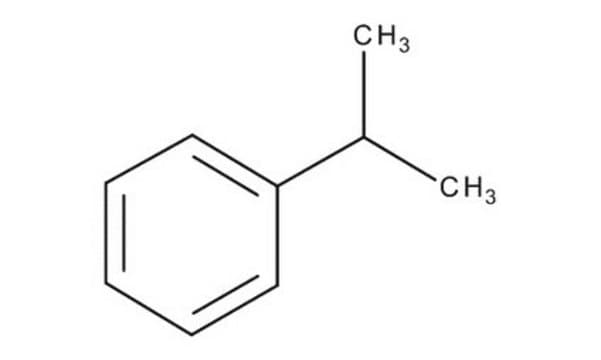28220
Cumene
analytical standard
Sinónimos:
(1-Methylethyl)benzene, 2-Phenylpropane, Isopropylbenzene, NSC 8776
Seleccione un Tamaño
110,00 €
Seleccione un Tamaño
About This Item
110,00 €
Productos recomendados
grado
analytical standard
Nivel de calidad
densidad de vapor
4.1 (vs air)
presión de vapor
8 mmHg ( 20 °C)
9.7 mmHg ( 37.7 °C)
Ensayo
≥99.5% (GC)
temp. de autoignición
797 °F
caducidad
limited shelf life, expiry date on the label
lim. expl.
6.5 %
técnicas
HPLC: suitable
gas chromatography (GC): suitable
índice de refracción
n20/D 1.491 (lit.)
n20/D 1.491
bp
152-154 °C (lit.)
mp
−96 °C (lit.)
densidad
0.864 g/mL at 25 °C (lit.)
aplicaciones
environmental
Formato
neat
temp. de almacenamiento
2-8°C
cadena SMILES
CC(C)c1ccccc1
InChI
1S/C9H12/c1-8(2)9-6-4-3-5-7-9/h3-8H,1-2H3
Clave InChI
RWGFKTVRMDUZSP-UHFFFAOYSA-N
¿Está buscando productos similares? Visita Guía de comparación de productos
Descripción general
Aplicación
Palabra de señalización
Danger
Frases de peligro
Consejos de prudencia
Clasificaciones de peligro
Aquatic Chronic 2 - Asp. Tox. 1 - Carc. 1B - Flam. Liq. 3 - STOT SE 3
Órganos de actuación
Respiratory system
Código de clase de almacenamiento
3 - Flammable liquids
Clase de riesgo para el agua (WGK)
WGK 3
Punto de inflamabilidad (°F)
87.8 °F - closed cup
Punto de inflamabilidad (°C)
31.0 °C - closed cup
Equipo de protección personal
Eyeshields, Faceshields, Gloves, type ABEK (EN14387) respirator filter
Listados normativos
Los listados normativos se proporcionan para los productos químicos principalmente. Para los productos no químicos sólo se puede proporcionar información limitada. Si no hay ninguna entrada, significa que ninguno de los componentes está en la lista. Es obligación del usuario garantizar el uso seguro y legal del producto.
EU REACH Annex XVII (Restriction List)
Elija entre una de las versiones más recientes:
¿Ya tiene este producto?
Encuentre la documentación para los productos que ha comprado recientemente en la Biblioteca de documentos.
Los clientes también vieron
Filtros activos
Nuestro equipo de científicos tiene experiencia en todas las áreas de investigación: Ciencias de la vida, Ciencia de los materiales, Síntesis química, Cromatografía, Analítica y muchas otras.
Póngase en contacto con el Servicio técnico












